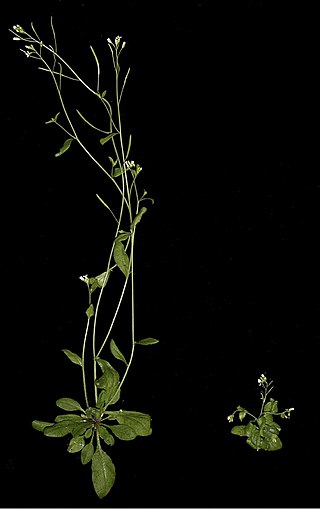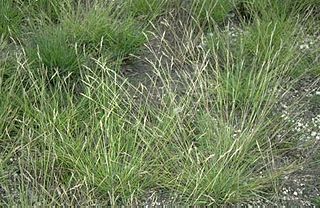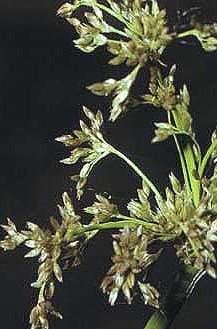
In botany, a seed is a plant embryo and food reserve enclosed in a protective outer covering called a seed coat (testa). More generally, the term "seed" means anything that can be sown, which may include seed and husk or tuber. Seeds are the product of the ripened ovule, after the embryo sac is fertilized by sperm from pollen, forming a zygote. The embryo within a seed develops from the zygote and grows within the mother plant to a certain size before growth is halted.

Germination is the process by which an organism grows from a seed or spore. The term is applied to the sprouting of a seedling from a seed of an angiosperm or gymnosperm, the growth of a sporeling from a spore, such as the spores of fungi, ferns, bacteria, and the growth of the pollen tube from the pollen grain of a seed plant.

Dormancy is a period in an organism's life cycle when growth, development, and physical activity are temporarily stopped. This minimizes metabolic activity and therefore helps an organism to conserve energy. Dormancy tends to be closely associated with environmental conditions. Organisms can synchronize entry to a dormant phase with their environment through predictive or consequential means. Predictive dormancy occurs when an organism enters a dormant phase before the onset of adverse conditions. For example, photoperiod and decreasing temperature are used by many plants to predict the onset of winter. Consequential dormancy occurs when organisms enter a dormant phase after adverse conditions have arisen. This is commonly found in areas with an unpredictable climate. While very sudden changes in conditions may lead to a high mortality rate among animals relying on consequential dormancy, its use can be advantageous, as organisms remain active longer and are therefore able to make greater use of available resources.

Plant hormones are signal molecules, produced within plants, that occur in extremely low concentrations. Plant hormones control all aspects of plant growth and development, including embryogenesis, the regulation of organ size, pathogen defense, stress tolerance and reproductive development. Unlike in animals each plant cell is capable of producing hormones. Went and Thimann coined the term "phytohormone" and used it in the title of their 1937 book.

Bromus tectorum, known as downy brome, drooping brome or cheatgrass, is a winter annual grass native to Europe, southwestern Asia, and northern Africa, but has become invasive in many other areas. It now is present in most of Europe, southern Russia, Japan, South Africa, Australia, New Zealand, Iceland, Greenland, North America and western Central Asia. In the eastern US B. tectorum is common along roadsides and as a crop weed, but usually does not dominate an ecosystem. It has become a dominant species in the Intermountain West and parts of Canada, and displays especially invasive behavior in the sagebrush steppe ecosystems where it has been listed as noxious weed. B. tectorum often enters the site in an area that has been disturbed, and then quickly expands into the surrounding area through its rapid growth and prolific seed production.

Plant propagation is the process by which new plants grow from various sources, including seeds, cuttings, and other plant parts. Plant propagation can refer to both man-made or natural dispersal of seeds.

Fire ecology is a scientific discipline concerned with the effects of fire on natural ecosystems. Many ecosystems, particularly prairie, savanna, chaparral and coniferous forests, have evolved with fire as an essential contributor to habitat vitality and renewal. Many plant species in fire-affected environments use fire to germinate, establish, or to reproduce. Wildfire suppression not only endangers these species, but also the animals that depend upon them.

Acmispon glaber is a perennial subshrub in the family Fabaceae. The plant is a pioneer species found in dry areas of California, Arizona, and Mexico. It is commonly found in many areas including chaparral, coastal sand and roadsides at elevations below 1500 m.

Sanguisorba minor, the salad burnet, garden burnet, small burnet, burnet, pimpernelle, Toper's plant, and burnet-bloodwort, is an edible perennial herbaceous plant in the family Rosaceae. It has ferny, toothed-leaf foliage; the unusual crimson, spherical flower clusters rise well above the leaves on thin stems. It generally grows to 25–55 cm tall. The large, long, taproots store water, making it drought-tolerant.

Myrmecochory ( ; from Ancient Greek: μύρμηξ, romanized: mýrmēks and χορεία khoreíā is seed dispersal by ants, an ecologically significant ant–plant interaction with worldwide distribution. Most myrmecochorous plants produce seeds with elaiosomes, a term encompassing various external appendages or "food bodies" rich in lipids, amino acids, or other nutrients that are attractive to ants. The seed with its attached elaiosome is collectively known as a diaspore. Seed dispersal by ants is typically accomplished when foraging workers carry diaspores back to the ant colony, after which the elaiosome is removed or fed directly to ant larvae. Once the elaiosome is consumed, the seed is usually discarded in underground middens or ejected from the nest. Although diaspores are seldom distributed far from the parent plant, myrmecochores also benefit from this predominantly mutualistic interaction through dispersal to favourable locations for germination, as well as escape from seed predation.

Serotiny in botany simply means 'following' or 'later'.
Seed dormancy is an evolutionary adaptation that prevents seeds from germinating during unsuitable ecological conditions that would typically lead to a low probability of seedling survival. Dormant seeds do not germinate in a specified period of time under a combination of environmental factors that are normally conducive to the germination of non-dormant seeds.

Melilotus albus, known as honey clover, white melilot (UK), Bokhara clover (Australia), white sweetclover (US), and sweet clover, is a nitrogen-fixing legume in the family Fabaceae. Melilotus albus is considered a valuable honey plant and source of nectar and is often grown for forage. Its characteristic sweet odor, intensified by drying, is derived from coumarin.

Geranium bicknellii is a species of geranium known by the common names Bicknell's cranesbill and northern cranesbill. It is native to much of the northern half of North America, where it can be found in a number of forest and woodland habitats. This is an annual or biennial herb which grows hairy stems up to about half a meter long. It may be erect or lie near the ground. Each leaf is several centimeters long and wide and is divided into several lobes, each of which may have smaller lobes or teeth. Flowers grow singly or in pairs and have pointed sepals and small lavender petals, each with a notch in the tip. The fruit has a rounded body with a long, straight style about 2 centimeters in length and tipped with a small beak.
Scarification in botany involves weakening, opening, or otherwise altering the coat of a seed to encourage germination. Scarification is often done mechanically, thermally, and chemically. The seeds of many plant species are often impervious to water and gases, thus preventing or delaying germination. Any process designed to make the testa more permeable to water and gases is known as scarification.

Karrikins are a group of plant growth regulators found in the smoke of burning plant material. Karrikins help stimulate seed germination and plant development because they mimic a signaling hormone known as strigolactone. Strigolactones are hormones that help increase growth of symbiotic arbuscular mycorrhizal fungi in the soil, which enhances plant growth and leads to an increase in plant branching.

Combretum glutinosum is a shrub species of the genus Combretum, found in the Sahel belt in parts of Senegal, Burkina Faso, Ghana, Mali, the Gambia, Niger, Nigeria and Cameroon, across to parts of Sudan. It is known as dooki in Pulaar, Kantakara in Hausa, rat in Wolof and jambakatan kè in Maninka. Its synonyms are Combretum cordofanum Engl. & Diels, C. passargei Engl. & Diels, C. leonense Engl. & Diels.

Danthonia spicata is a species of grass known by the common name poverty oatgrass, or simply poverty grass. It is native to North America, where it is widespread and common in many areas. The species is distributed across much of Canada and the United States, and its distribution extends into northern Mexico.

Juncus roemerianus is a species of flowering plant in the rush family known by the common names black rush, needlerush, and black needlerush. It is native to North America, where its main distribution lies along the coastline of the southeastern United States, including the Gulf Coast. It occurs from New Jersey to Texas, with outlying populations in Connecticut, New York, Mexico, and certain Caribbean islands.

Fire adaptations are traits of plants and animals that help them survive wildfire or to use resources created by wildfire. These traits can help plants and animals increase their survival rates during a fire and/or reproduce offspring after a fire. Both plants and animals have multiple strategies for surviving and reproducing after fire. Plants in wildfire-prone ecosystems often survive through adaptations to their local fire regime. Such adaptations include physical protection against heat, increased growth after a fire event, and flammable materials that encourage fire and may eliminate competition.

![3-Methyl-2H-furo[2,3-c]pyran-2-one, found in "smokewater" 3-methyl-2H-furo-2,3-c-pyran-2-one.png](http://upload.wikimedia.org/wikipedia/commons/thumb/c/c4/3-methyl-2H-furo-2%2C3-c-pyran-2-one.png/220px-3-methyl-2H-furo-2%2C3-c-pyran-2-one.png)

















